GEMSTONES
Gemstones also called precious or semi-precious stones are very valuable and rare clear, translucent, and homogeneous varieties of certain rocks and minerals. Gemstones of floral (amber) and faunal origin (pearl, coral) are an exception. These stones exhibit high lustre and attractive colour or entire lack of colour. Gemstones are very durable and hard. We use them in jewellery making where they are usually set in gold, silver or other precious metal.
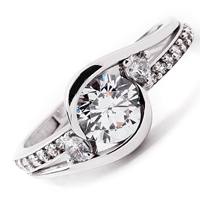 |
Diamond Diamond is native element class mineral. Its name derives from Latin word diamentum that means invincible, indestructible which refers to |
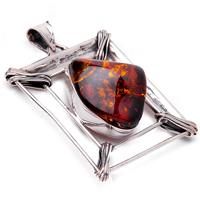 |
Amber Amber is fossilized tree resin. Mostly of yellow to brown colours, it can also be milky white, blue, green, colourless, red or black. Blocks of this gemstone sometimes include mineral traces or animal or plant remnants of the Cretaceous and the Cenozoic eras. Moderate amounts of amber occur all over the world, though Baltic amber is most valued in jewellery making. Estimated 90% of world deposits are located at the Russian shore of the Baltic sea. Gdansk in Poland is home to the largest international amber fairs. In traditional medicine amber was believed to have healing properties. It was to cure throat and thyroid illnesses, rheumatism, headaches and the cold. |
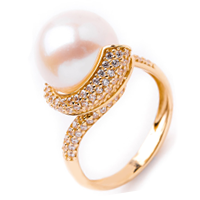 |
Pearl Pearls are product of a mussel or other mollusc in response to a foreign body entering its shell. It is made of the same substance as the inner lining of the shell, which is the mother-of-pearl. Pearl can be white, but also black, brown, blue, cream, pink or fancy i.e. with orient or overtone, sparkling with colours. |
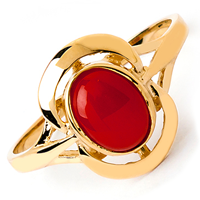 |
Coral Coral is calcareous skeletons of marine corals that form e.g. reefs and atolls. Corals can be white, white with pink dots, blood-red, pale pink, red, dark red, garnet, purple, blue or black. They are most common in the Mediterranean Sea. Torre del Greco in Italy is the main trade centre for coral and 75% of world corals are processed there. Other areas with precious corals are the Red Sea, the shores of Japan, Africa, Asia, and Hawaii. Ancient Romans hung coral branches round children's necks to protect them from danger and until 20th century coral was worn for protection against the evil eye in Italy. Women wore it also as protection from infertility. |
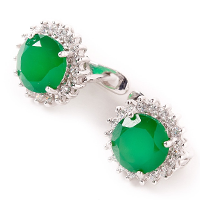 |
Agate Agate is semi-precious mineral. Agate is a colourful, banded variety of chalcedony created in set lava. The name derives from the River Achates (now called Dirillo) in Sicily. Ancients wore agate on breastplates for strength and courage in battle, and they made seals of it. |
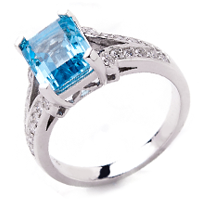 |
Aquamarine Name coming from Latin aqua marina what means sea water. Blue or cyan mineral depending on the amount of iron componds impurities. It is a gemstone quality translucent variety of beryl. Ancient peoples wore it for protection during sea voyages. |
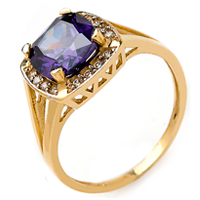 |
Amethyst Transparent purple or violet variety of milky quartz. Its name derives from Greek a méthystos, which means not drunk. Ancient Greeks believed drinking wine from amethyst vessels prevented drunkenness. Amethyst is set in the Pope's ring. |
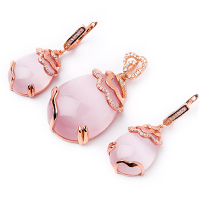 |
Chrysoberyl Rare oxide class mineral. In jewellery making it is mostly transparent of yellow or green colour. The name comes from Greek words chrysos – gold and beryllos – beryl. Alexandrite and cat's eye are its rarest and most precious varieties. |
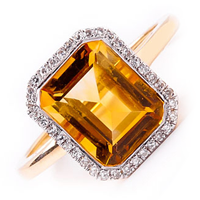 |
Citrine Precious stone, a variety of quartz. The name derives from old French citrin – yellow. Its pale yellow to dark brown colour is caused by the presence of ferric hydroxide impurities. Citrines change colour after heating, e.g. Brazilian citrines from Montezuma mine turn green.
|
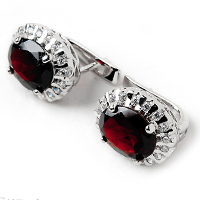 |
Garnet Group of silicate minerals of dark red to bright green colours. Their name comes from the Latin word granatus that means pomegranate, as the gemstone was likened to pomegranate seeds. Garnet has been used since the Bronze Age. In South Africa it is a by-product in diamond mining. |
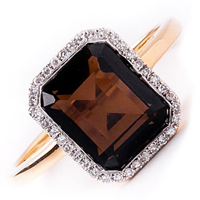 |
Quartz Tectosilicate mineral. Clear colourless quartz is otherwise called mountain crystal or rock crystal. Quartz is the most common mineral in the Earth's crust. Tools made of flint (a variety of quartz) were made as early as in Stone Age. Nowadays aside from jewellery it is used e.g. for production of toothpaste. |
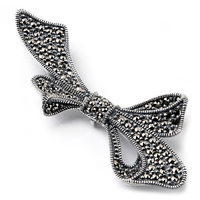 |
Marcasite Sulfide mineral. The name derives from Arabic marqasitae or Persian marcasisa, used for both pyrite and marcasite. Marcasite jewellery is in fact made from more durable pyrite, however the name marcasite is a traditional Medieval name that referred to pyrite as well. |
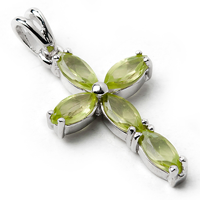 |
Olivine Olivine group of silicate minerals. The precious variety of olivines is called peridot. Peridot was found in space dust samples collected by Stardust probe launched in 1999 to research the dust of a comet. The sultanic gold throne in the palace museum of Topkapi in Istambul, Turkey is adorned with 954 green olivines. |
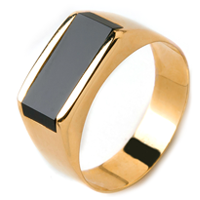 |
Onyx Mineral, a variety of chalcedony with parallel layers: black and white alternately. The name comes from Greek onux that means claw, nail. It refers to the mineral's hardness, appearance and sharp edges. It has been known since the Ancient times and has been the most common material for cameos and seals for centuries. |
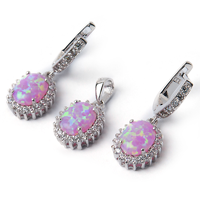 |
Opal Silicate mineraloid, best known photonic crystal. Precious opal display characteristic optical phenomenons such as opalization, opalescence, cat's eye effect, and asterism. Ancient Romans imported it from India where it was known as upala – precious stone. Opal is the national gemstone of Australia. |
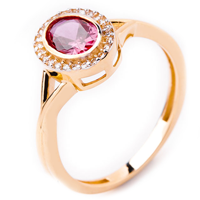 |
Ruby Gemstone of pink to blood-red colour. This rare mineral is a variety of corundum. Ruby is a tough and durable gemstone; only diamond is tougher in the nature. Bangkok in Thailand is the world centre for ruby trade. In 2000 deposits of ruby were discovered in Madagascar that has since joined ruby mining leaders. |
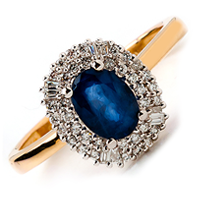 |
Sapphire Very hard mineral, a blue variety of corundum. It is a rare mineral. Its name derives from ancient Greek sappheiros which mainly referred to lapis lazuli i.e. the colour of the sky. Vast majority of sapphires are heated to intesify their blue colour and naturally intense stones are particularly expensive. |
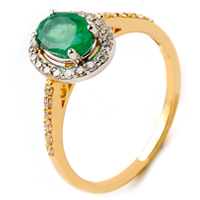 |
Emerald Variety of beryl. Its name derives from Vulgar a variety of Latin smaragdus that means green. This refers to the distinct colour of this mineral. It was particularly valued in ancient Egypt, Persia and Arabia, but also with the Aztec, Inca and Maya. Columbia had been the traditional source of best emeralds for centuries until even better deposits were discovered in Zambia recently. |
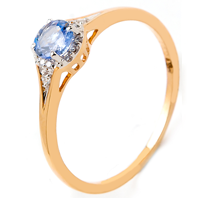 |
Tanzanite Transparent variety of zoisite discovered in 1967 in Tanzania. It is the only known source of tanzanite so far. Tiffany have introduced the name in 1969 after the name of the country. Naturally tanzanites are greyish or brownish so all are heated to approx. 430°C for deep blue or violet colour. |
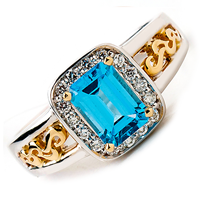 |
Topaz Slicate class mineral. A mineral widely spread in many parts of the world. Its name derives from Greek topázios what means to search, or topas what means fire and refers to orange and gold colour and shine of the precious varieties of this mineral. Brazil is the biggest producer. Colourless topaz, much cheaper than diamonds, is becoming a more and more popular choice. |
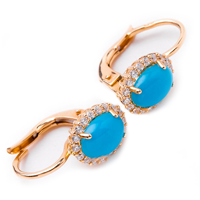 |
Turquoise Rare phosphate mineral. The name comes from French turquoise – Turkish, because of a trade route that led from Persia to Europe through Turkey. For some 6000 years turquoise has been a favourite gemstone for art and jewellery in Africa, South America, North America and Asia. Some turquoises include veins of mother rock called matrix. |
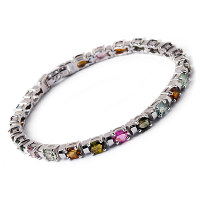 |
Tourmaline Tourmalines are group of silicate minerals of various colours. Red, green, blue and multicoloured tourmalines are particularly popular. The main mining areas are in Asia, the U.S.A and Africa. The name derives from Sinhalese turmali that referred to the stone's ability to draw the ash from fire when heated. |
DIAMOND COLOUR AND CLARITY
COLOUR
Vast majority of mined diamonds are coloured. There are diamonds of fancy colours such as blue, pink, or orange as well as diamonds of typical colours, i.e. from colourless to various shades of yellow, brown or grey. It is estimated that in every 10 thousand stones of typical colours there occurs only one stone of a fancy colour. Among diamonds of typical colours, graded on a scale from D to Z, entirely colourless stones rated D are the rarest and most valuable ones. The scale of diamond colourlessness grades was created by the Gemological Institute of America and has been in common use. Differences between typical colours of diamonds are very subtle, therefore the grade of colourlessness is determined in special conditions of lighting by comparing against patterns. Descriptions like cool white and warm white, among others, are used. This scale is not applicable to fancy coloured diamonds.
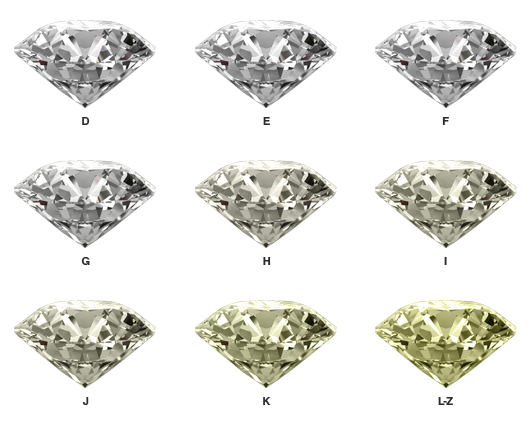
CLARITY
The clarity of a diamond is one of its basic attributes. It is defined by the number, size, but mostly the intensity of internal imperfections of the diamond. The less flaws there are the more valuable the stone is.

Flawless or Internally Flawless: Fl / IF
Stones certified with this symbol are exceptionally rare. Such stones have no internal imperfections. They may however have delicate blemishes on the surface that do not affect the brilliance of the diamond.
Very Very Slightly Included 1: VVS1
Diamonds of this quality have one small inclusion visible only through a powerful microscope. Therefore the inclusion is not visible to the naked eye and the stone appears ideally clear. Stones of this clarity are nearly as rare as stones rated IF.
Very Very Slightly Included 2: VVS2
These diamonds have only two small inclusions falling into VVS1 classification; they also can only be seen through a powerful microscope. Stones rated VVS2 are much cheaper than VVS1 although they still present a very high level of brilliance.
Very Slightly Included 1: VS1
VS1 have one small or a few very tiny inclusions not visible to the naked eye. They can hardly be seen through a magnifying glass. VS1 are an excellent choice because the stones are still “pure to the naked eye” but also much cheaper than VVS group.
Very Slightly Included 2: VS2
Usually stones rated VS2 have a number of small inclusions. 95% diamonds rated VS2 are pure to the naked eye.
Slightly Included 1: SI1
SI1 have one average or a few very small inclusions that are almost always visible to the naked eye and can easily be seen through a magnifying glass. Depending on intensity and colour of the inclusions SI1 still are a very good choice.
Slightly Included 2: SI2
Diamonds rated SI2 have a larger number of inclusions that are almost always visible to the naked eye. Similarly to SI1, diamonds rated SI2 can present very good value depending on inclusions.
I1 and less
These diamonds always have inclusions visible to the naked eye. We do not recommend purchase of diamonds in this category.
SYNTHETIC STONES
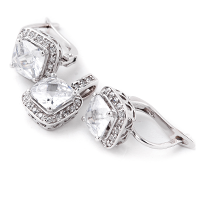 |
Zirconia Zirconium dioxide, synthetic gemstone obtained by calcining zirconium compounds. It is synthesized in various colours. During the heating process zirconia trasforms from the monoclinic structure to tetragonal to cubic. Cubic zirconia is thus the stone of the most symmetric internal structure, most perfect zirconia. It was first marketed in 1973. Zirconia is considered the most ideal diamond simulant because it has a similar structure and similarly high index of refraction. |
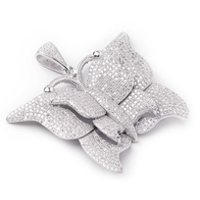 |
Swarovski crystal Swarovski company founded in 1895 by Czech Daniel Swarovski in Austria, specialises in production of lead glass called crystal glass, or colloquially “crystal”. Adding lead to glass causes a number of changes to the glass'es physical properties. The index of refraction and average dispersion increase giving crystal glass its typical shine and spreading the light at deep cuts spectacularly. Lead glass is also softer and easier to melt than conventional glass and therefore easier to carve and form. Beautiful decoration is made from clear and coloured crystal glass. |
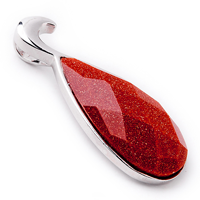 |
Desert sand Aventurine glass (Venetian glass) of golden-red colour. |
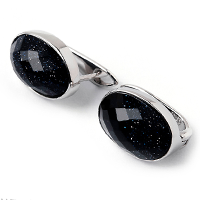 |
Cairo night Aventurine glass (Venetian glass) of dark blue colour. |
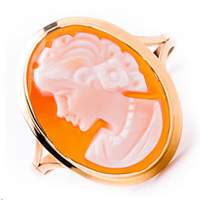 |
Camea Cameo is a precious or semi-precious stone decorated with a raised relief. The name derives from the Arabic word kamma – hump, convexity. Cameos were commonly made in the ancient times, mostly from double coloured layer stones like onyx. Because double coloured gemstones are very scarce though, cameos were often made from two different stones put together. Cameos got back into fashion during the Renaissance with fascination by all things ancient. Since gemstone cameos were costly, copies were made in wax, sealing wax, glass and other materials. In the second part of 19th century cameo returned as a brooch often attached to women's dresses high at the neck. |
GEMSTONE SHAPES
 |
Round Brilliant |
 |
Princess |
 |
Emerald |
 |
Pear |
 |
Oval |
 |
Marquise |
 |
Heart |
 |
Cushion |
BIRTHSTONES
For many centuries and in different cultures, various gemstones were attributed to particular dates of birth. Such stone was to bring well-being and protect from diseases and disasters.
According to Indian tradition of ayurveda nine stones corelate with nine planets or points in the sky. Thus ruby relates to the Sun, pearl to the Moon, yellow sapphire to Jupiter, hessonite to Rahu, emerald to Mercury, diamond to Venus, cat's eye to Ketu, blue sapphire to Saturn, and coral to Mars.
The symbolism of twelve stones has its source in the Bible. We read such description of Aaron's breastpiece in the Book of Exodus 28:17-21:
“17 Then mount four rows of precious stones on it. The first row shall be carnelian, chrysolite and beryl; 18 the second row shall be turquoise, lapis lazuli and emerald; 19 the third row shall be jacinth, agate and amethyst; 20 the fourth row shall be topaz, onyx and jasper. Mount them in gold filigree settings. 21 There are to be twelve stones, one for each of the names of the sons of Israel, each engraved like a seal with the name of one of the twelve tribes.”
Nowadays, twelve stones are represent twelve months. The tradition of wearing birthstones comes from central Europe of 16th - 18th centuries depending on the source. Below is the most popular choice of birthstones in the western culture. They Were put together more than a hundred years ago in 1912 in Kansas, USA by the National Asspciation of Jewellers (with a later addition of tanzanite).
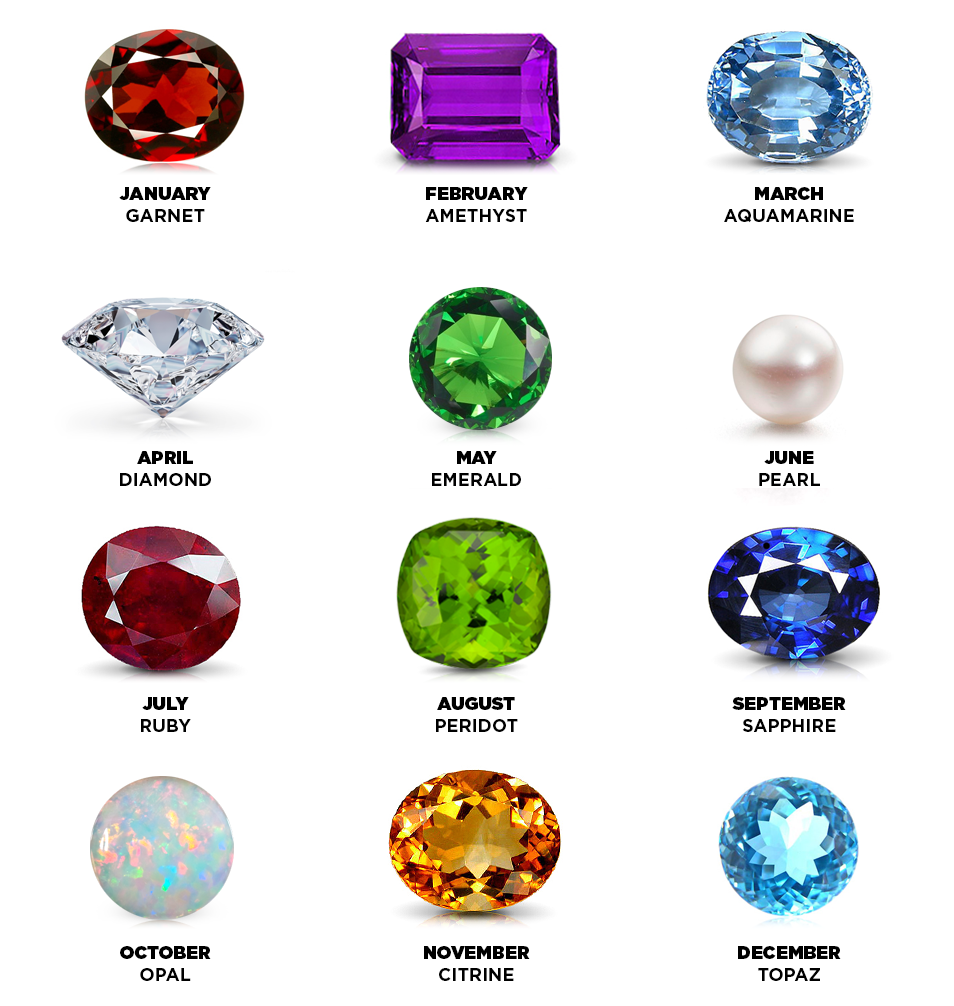




 33 300 10 20
33 300 10 20 Karpacka 24 Bielsko-Biała
Karpacka 24 Bielsko-Biała

